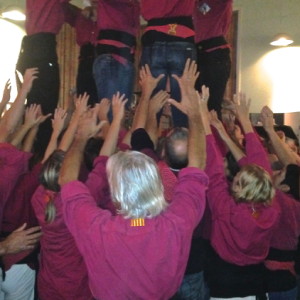Tonight we went to the first showing of a French film four years in the making, The Pyrénées from the Atlantic to the Mediterranean. At the end of the evening aperitifs were served and a cast eel was built in the foyer. A castell is a human tower built traditionally in festivals at many locations within Catalonia. At these festivals, several colles castelleres or teams often succeed in building and dismantling a tower's structure. On November 16, 2010, castells were declared by UNESCO be amongst the Masterpieces of the Oral and Intangible Heritage of Humanity.
A castell is considered a success when stages of its assembling and disassembling, can be done in complete succession. The assembly is complete once all castellers have climbed into their designated places, and the enxaneta climbs into place at the top and raises one hand with four fingers erect, in a gesture said to symbolize the stripes of the Catalan flag. The enxaneta then climbs down the other side of the castell, after which the remaining levels of castellers descend in highest-to-lowest order until all have reached safety.
Aside from the people who climb to form the upper parts of the tower, others are needed to form the pinya, or bottom base of the castell, to sustain its weight. Members of the pinya (most often men) also act as a 'safety net' if the tower structure collapses, cushioning the fall of people from the upper levels. It is not uncommon—when not in competitions—for other colles to assist in the pinya when a small colla is attempting a specially demanding structure in terms of people needed.
The castell is built in two phases. First, the pinya—the base of the tower—is formed. People forming higher levels of the tower move to a position from which they can easily get to their place in the tower. This is done slowly and carefully, and as subsequent base levels are completed the castellers in the pinya determine if their base is solid enough for construction to continue. Then, when the signal to proceed is given, bands begin to play the traditional Toc de Castells music as a hush comes over spectators of the event. The upper layers of the tower are built as quickly as possible in order to put minimal strain on the lower castellers, who bear most of the weight of the castell. The disassembly of the castell, done amidst the cheering of the crowd, is often the most treacherous stage of the event.
There is a form of the Castell, generally referred to as 'rising', in which each successive layer is added from the bottom by lifting the castell into the air, stage by stage. It is held that this form takes even more skill and strength and a great deal of practice. Four levels complete have been observed and five attempted, but it is said that the record is six or perhaps seven.
Typically castellers wear white trousers, a black sash, a bandana and a coloured shirt often bearing the team's emblem. A differently coloured shirt indicates which team a participant is in. For instance, Castellers de Barcelona team wear red shirts while Castellers de Vilafranca wear green shirts.
The sash (faixa) is the most important part of their outfit, since it supports the lower back and is used by other castellers in the team as a foothold or handhold when climbing up the tower. This tasselled piece of cloth varies in length and width and depends on the casteller's position inside the tower and also on choice. The length of the sash ranges from 1.5 to 12 m, and usually is shorter for those higher up in the castell. Performing castellers usually go barefoot as to minimise injuries upon each other as they climb to their position and also for sensitivity when balancing and to have better feel and hold each other.
The arrangement of castellers can be into a multi-tiered structure and the highest has a height spanning of nine or ten people from ground up. The motto of Castellers is "Força, equilibri, valor i seny" (Strength, balance, courage and common sense).
Strength: A casteller is usually a stocky person. The first castellers were peasants that were accustomed to holding great weights and were under much physical exertion.
Balance: For supporting other above in the castell while relying on those below for support requires a strong sense of balance and trust.
Courage: The most important characteristic for castellers, especially for young children forming the highest levels of the castell.
Common sense: Rehearsing and performing requires a great deal of planning and reasoning. Any error can cause the structure to fail and break apart.
Accidents are rare during the construction of a castell; however, as in bull runs ambulances are stationed nearby in case a person needs immediate attention. Fatal accidents do occur, such as on July 23, 2006, in Mataró a young casteller fell off the formation of a castell and died. Prior to this, the previous death of a participant was in 1983 in Torredembarra.
Thanks Wikipedia!


Comments
Sign in or get an account to comment.


